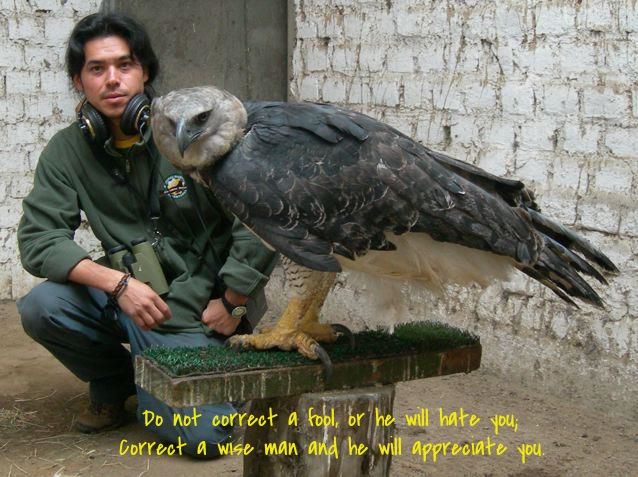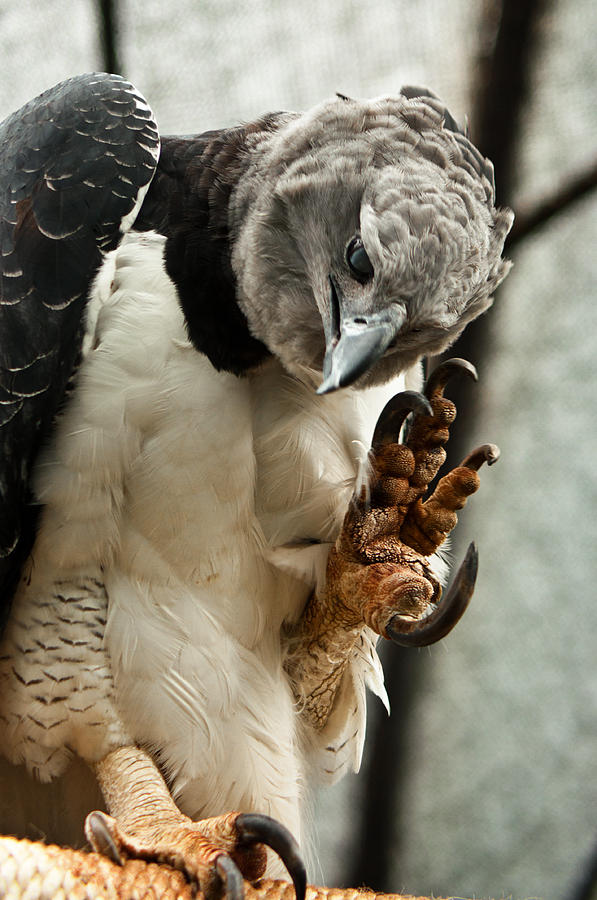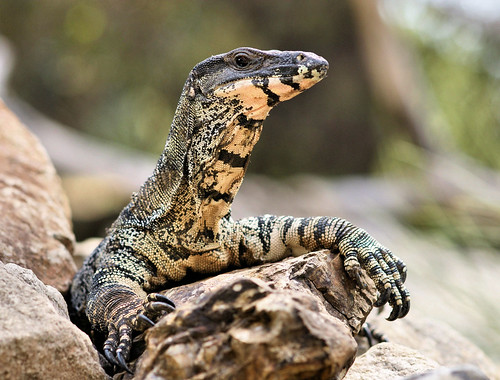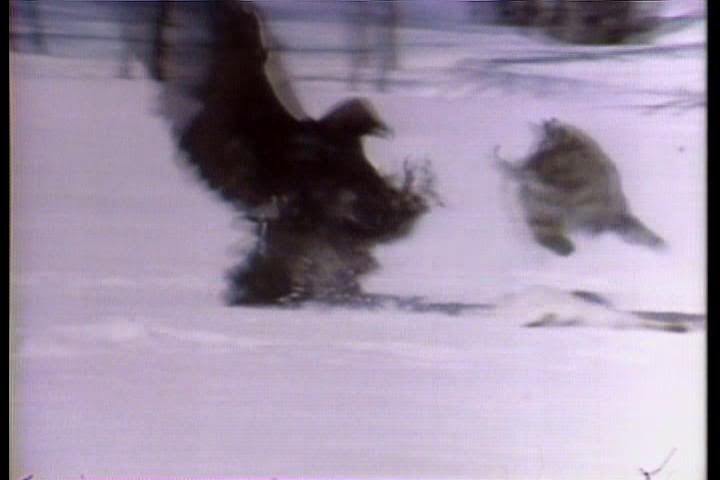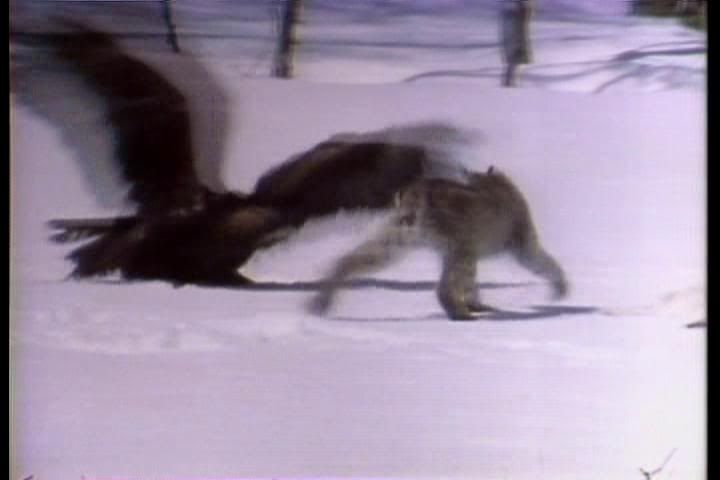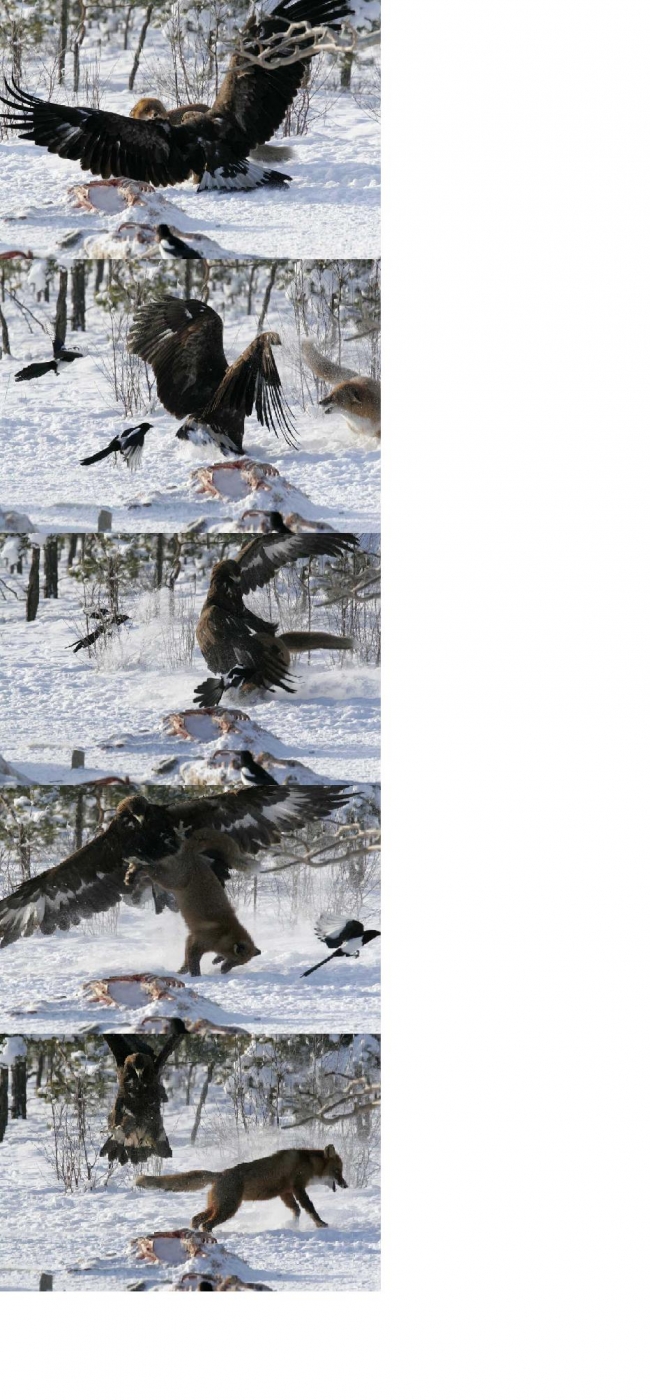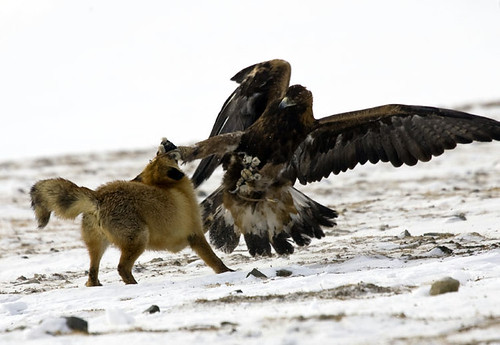Post by Runic on Jun 3, 2013 8:58:23 GMT 5
Harpy Eagle (Harpia harpyja)


The upper side of the Harpy Eagle is covered with slate black feathers,
and the underside is mostly white, except for the feathered tarsi, which
are striped black. There is a broad black band across the upper breast,
separating the gray head from the white belly. The head is pale grey,
and is crowned with a double crest. The upperside of the tail is black
with three gray bands, while the underside of it is black with three
white bands. The iris is gray or brown or red, the cere and bill are
black or blackish and the tarsi and toes are yellow. The plumage of male
and female is identical. The tarsus is up to 13 cm (5.1 in) long.[7][8]
Female
Harpy Eagles typically weigh 6 to 9 kg (13 to 20 lb).[7][9] One source
states that adult females can scale up to 10 kg (22 lb).[10] An
exceptionally large captive female, "Jezebel", weighed 12.3 kg (27
lb).[11] Being captive, this large female may not be representative of
the weight possible in wild Harpy Eagles due to differences in the food
availability.[12][13] The male, in comparison, is much smaller and
weighs only about 4 to 4.8 kg (8.8 to 11 lb).[7][9] Harpy Eagles are
86.5–107 cm (2 ft 10 in–3 ft 6 in) long[8][9] and have a wingspan of 176
to 224 cm (5 ft 9 in to 7 ft 4 in).[7][8] Among the standard
measurements, the wing chord measures 54–63 cm (1 ft 9 in–2 ft 1 in),
the tail measures 37–42 cm (1 ft 3 in–1 ft 5 in), the tarsus is 11.4–13
cm (4.5–5.1 in) long and the exposed culmen from the cere is 4.2 to 6.5
cm (1.7 to 2.6 in).[7][14][15]
It is sometimes cited as the
largest eagle alongside the Philippine Eagle, that is somewhat longer on
average and the Steller's Sea Eagle, that is slightly heavier on
average.[6] The wingspan of the Harpy Eagle is relatively small, an
adaptation that increases maneuverability in forested habitats and is
shared by other raptors in similar habitats. The wingspan of the Harpy
Eagle is surpassed by several large eagles who live in more open
habitats, such as those in the Haliaeetus and Aquila genera.[7] The
extinct Haast's Eagle was significantly larger than all extant eagles,
including the Harpy.[16]
Vs
Bobcat (Lynx rufus)
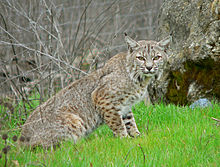
The bobcat (Lynx rufus) is a North American mammal of the cat family Felidae, appearing during the Irvingtonian stage of around 1.8 million years ago (AEO).[3] With 12 recognized subspecies, it ranges from southern Canada to northern Mexico, including most of the continental United States. The bobcat is an adaptable predator
that inhabits wooded areas, as well as semidesert, urban edge, forest
edges, and swampland environments. It persists in much of its original
range, and populations are healthy.
With a gray to brown coat, whiskered face, and black-tufted ears, the bobcat resembles the other species of the mid-sized Lynx genus. It is smaller on average than the Canada lynx, with which it shares parts of its range, but is about twice as large as the domestic cat. It has distinctive black bars on its forelegs and a black-tipped, stubby tail, from which it derives its name.
Though the bobcat prefers rabbits and hares, it will hunt anything from insects, chickens, and small rodents to deer.
Prey selection depends on location and habitat, season, and abundance.
Like most cats, the bobcat is territorial and largely solitary, although
with some overlap in home ranges. It uses several methods to mark its territorial boundaries,
including claw marks and deposits of urine or feces. The bobcat breeds
from winter into spring and has a gestation period of about two months.
Although bobcats have been hunted extensively by humans, both for
sport and fur, their population has proven resilient. The elusive
predator features in Native American mythology and the folklore of European settlers.
The bobcat resembles other species of the Lynx genus, but is
on average the smallest of the four. Its coat is variable, though
generally tan to grayish-brown, with black streaks on the body and dark
bars on the forelegs and tail. Its spotted patterning acts as
camouflage. The ears are black-tipped and pointed, with short, black
tufts. There is generally an off-white color on the lips, chin, and
underparts. Bobcats in the desert regions of the southwest have the
lightest-colored coats, while those in the northern, forested regions
are darkest. Kittens are born well-furred and already have their spots.[10] A few melanistic bobcats have been sighted and captured in Florida. They appear black, but may still exhibit a spot pattern.[11]
The face appears wide due to ruffs of extended hair beneath the ears.
Bobcat eyes are yellow with black pupils. The nose of the bobcat is
pinkish-red, and it has a base color of gray or yellowish- or
brownish-red on its face, sides, and back.[12] The pupils are round, black circles and will widen during nocturnal activity to maximize light reception.[13]
The cat has sharp hearing and vision, and a good sense of smell. It is
an excellent climber, and will swim when it needs to, but will normally
avoid water.[14]
The adult bobcat is 47.5 to 125 cm (18.7 to 49 in) long from the head
to the base of the tail, averaging 82.7 cm (32.6 in); the stubby tail
adds 9 to 20 cm (3.5 to 7.9 in) [12] and its "bobbed" appearance gives the species its name.[15][16][17][18] An adult stands about 30 to 60 cm (12 to 24 in) at the shoulders.[10][19]
Adult males can range in weight from 6.4 to 18.3 kg (14 to 40 lb), with
an average of 9.6 kg (21 lb); females at 4 to 15.3 kg (8.8 to 34 lb),
with an average of 6.8 kg (15 lb).[20][21]
The largest bobcat accurately measured on record weighed 22.2 kg
(49 lb), although unverified reports have them reaching 27 kg (60 lb).[22] Furthermore, a June 20, 2012 report of a New Hampshire roadkill specimen listed the animal's weight at 27 kg (60 lb).[23] The largest-bodied bobcats are from eastern Canada and northern New England of the subspecies (L. r. gigas), while the smallest are from the southeastern subspecies (L. r. floridanus), particularly those in the southern Appalachians.[24]
The bobcat is muscular, and its hind legs are longer than its front
legs, giving it a bobbing gait. At birth, it weighs 0.6 to 0.75 lb (270
to 340 g) and is about 10 in (25 cm) in length. By its first birthday,
it will reach about 10 lb (4.5 kg).


The upper side of the Harpy Eagle is covered with slate black feathers,
and the underside is mostly white, except for the feathered tarsi, which
are striped black. There is a broad black band across the upper breast,
separating the gray head from the white belly. The head is pale grey,
and is crowned with a double crest. The upperside of the tail is black
with three gray bands, while the underside of it is black with three
white bands. The iris is gray or brown or red, the cere and bill are
black or blackish and the tarsi and toes are yellow. The plumage of male
and female is identical. The tarsus is up to 13 cm (5.1 in) long.[7][8]
Female
Harpy Eagles typically weigh 6 to 9 kg (13 to 20 lb).[7][9] One source
states that adult females can scale up to 10 kg (22 lb).[10] An
exceptionally large captive female, "Jezebel", weighed 12.3 kg (27
lb).[11] Being captive, this large female may not be representative of
the weight possible in wild Harpy Eagles due to differences in the food
availability.[12][13] The male, in comparison, is much smaller and
weighs only about 4 to 4.8 kg (8.8 to 11 lb).[7][9] Harpy Eagles are
86.5–107 cm (2 ft 10 in–3 ft 6 in) long[8][9] and have a wingspan of 176
to 224 cm (5 ft 9 in to 7 ft 4 in).[7][8] Among the standard
measurements, the wing chord measures 54–63 cm (1 ft 9 in–2 ft 1 in),
the tail measures 37–42 cm (1 ft 3 in–1 ft 5 in), the tarsus is 11.4–13
cm (4.5–5.1 in) long and the exposed culmen from the cere is 4.2 to 6.5
cm (1.7 to 2.6 in).[7][14][15]
It is sometimes cited as the
largest eagle alongside the Philippine Eagle, that is somewhat longer on
average and the Steller's Sea Eagle, that is slightly heavier on
average.[6] The wingspan of the Harpy Eagle is relatively small, an
adaptation that increases maneuverability in forested habitats and is
shared by other raptors in similar habitats. The wingspan of the Harpy
Eagle is surpassed by several large eagles who live in more open
habitats, such as those in the Haliaeetus and Aquila genera.[7] The
extinct Haast's Eagle was significantly larger than all extant eagles,
including the Harpy.[16]
Vs
Bobcat (Lynx rufus)

The bobcat (Lynx rufus) is a North American mammal of the cat family Felidae, appearing during the Irvingtonian stage of around 1.8 million years ago (AEO).[3] With 12 recognized subspecies, it ranges from southern Canada to northern Mexico, including most of the continental United States. The bobcat is an adaptable predator
that inhabits wooded areas, as well as semidesert, urban edge, forest
edges, and swampland environments. It persists in much of its original
range, and populations are healthy.
With a gray to brown coat, whiskered face, and black-tufted ears, the bobcat resembles the other species of the mid-sized Lynx genus. It is smaller on average than the Canada lynx, with which it shares parts of its range, but is about twice as large as the domestic cat. It has distinctive black bars on its forelegs and a black-tipped, stubby tail, from which it derives its name.
Though the bobcat prefers rabbits and hares, it will hunt anything from insects, chickens, and small rodents to deer.
Prey selection depends on location and habitat, season, and abundance.
Like most cats, the bobcat is territorial and largely solitary, although
with some overlap in home ranges. It uses several methods to mark its territorial boundaries,
including claw marks and deposits of urine or feces. The bobcat breeds
from winter into spring and has a gestation period of about two months.
Although bobcats have been hunted extensively by humans, both for
sport and fur, their population has proven resilient. The elusive
predator features in Native American mythology and the folklore of European settlers.
The bobcat resembles other species of the Lynx genus, but is
on average the smallest of the four. Its coat is variable, though
generally tan to grayish-brown, with black streaks on the body and dark
bars on the forelegs and tail. Its spotted patterning acts as
camouflage. The ears are black-tipped and pointed, with short, black
tufts. There is generally an off-white color on the lips, chin, and
underparts. Bobcats in the desert regions of the southwest have the
lightest-colored coats, while those in the northern, forested regions
are darkest. Kittens are born well-furred and already have their spots.[10] A few melanistic bobcats have been sighted and captured in Florida. They appear black, but may still exhibit a spot pattern.[11]
The face appears wide due to ruffs of extended hair beneath the ears.
Bobcat eyes are yellow with black pupils. The nose of the bobcat is
pinkish-red, and it has a base color of gray or yellowish- or
brownish-red on its face, sides, and back.[12] The pupils are round, black circles and will widen during nocturnal activity to maximize light reception.[13]
The cat has sharp hearing and vision, and a good sense of smell. It is
an excellent climber, and will swim when it needs to, but will normally
avoid water.[14]
The adult bobcat is 47.5 to 125 cm (18.7 to 49 in) long from the head
to the base of the tail, averaging 82.7 cm (32.6 in); the stubby tail
adds 9 to 20 cm (3.5 to 7.9 in) [12] and its "bobbed" appearance gives the species its name.[15][16][17][18] An adult stands about 30 to 60 cm (12 to 24 in) at the shoulders.[10][19]
Adult males can range in weight from 6.4 to 18.3 kg (14 to 40 lb), with
an average of 9.6 kg (21 lb); females at 4 to 15.3 kg (8.8 to 34 lb),
with an average of 6.8 kg (15 lb).[20][21]
The largest bobcat accurately measured on record weighed 22.2 kg
(49 lb), although unverified reports have them reaching 27 kg (60 lb).[22] Furthermore, a June 20, 2012 report of a New Hampshire roadkill specimen listed the animal's weight at 27 kg (60 lb).[23] The largest-bodied bobcats are from eastern Canada and northern New England of the subspecies (L. r. gigas), while the smallest are from the southeastern subspecies (L. r. floridanus), particularly those in the southern Appalachians.[24]
The bobcat is muscular, and its hind legs are longer than its front
legs, giving it a bobbing gait. At birth, it weighs 0.6 to 0.75 lb (270
to 340 g) and is about 10 in (25 cm) in length. By its first birthday,
it will reach about 10 lb (4.5 kg).



